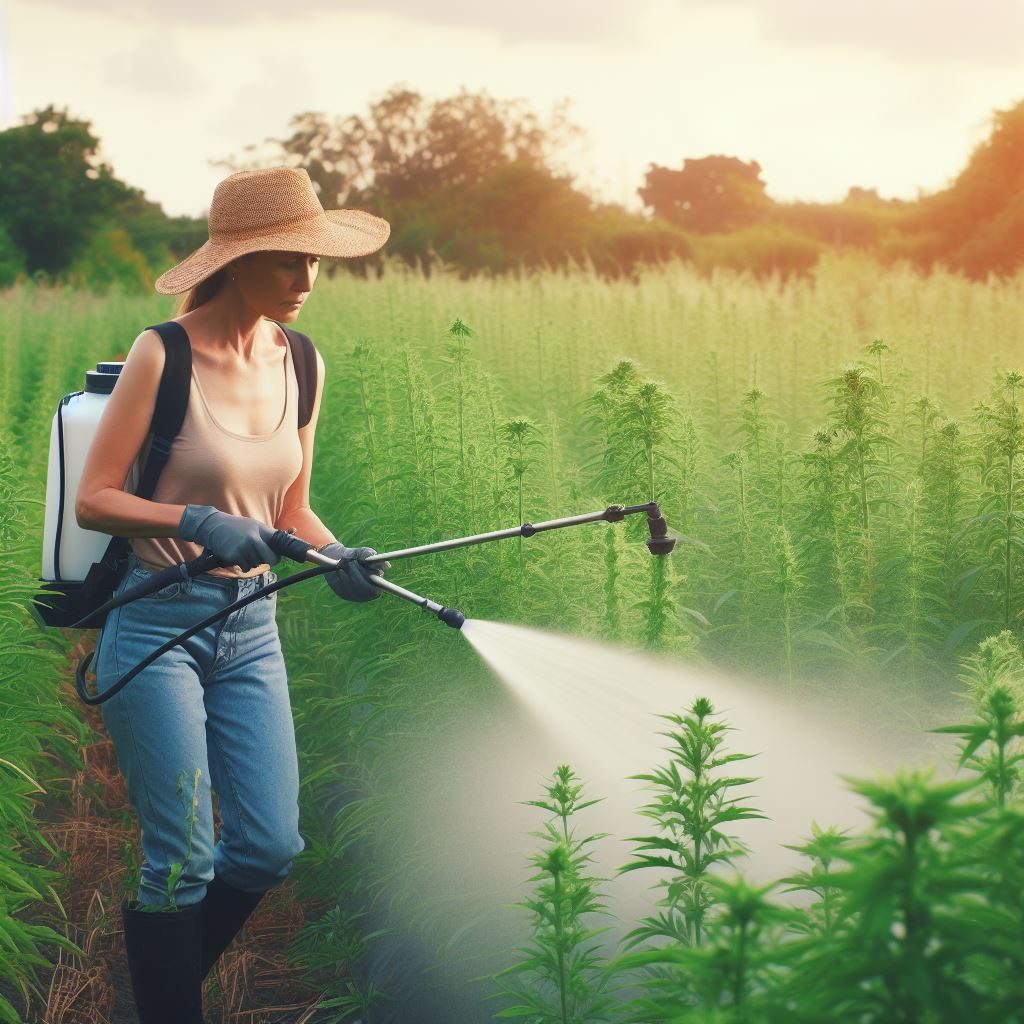Introduction
In farming, weed eradication plays a crucial role in ensuring the success of crops. Weeds compete with crops for nutrients, water, and sunlight, leading to reduced yields.
Moreover, weeds can serve as hosts for diseases and pests that further harm crops. Therefore, it is essential to implement effective weed management strategies.
Advanced techniques for weed eradication can bring about significant improvements in crop yields and reduce labor costs.
By utilizing these techniques, farmers can minimize the competition between weeds and crops, allowing crops to receive optimal amounts of nutrients, water, and sunlight. This, in turn, leads to higher yields.
One such advanced technique is the use of precision agriculture technology. This technology enables farmers to precisely apply herbicides only where they are needed, reducing herbicide use and minimizing the impact on the environment.
It also allows farmers to target specific weed species, ensuring effective control.
Another advanced technique is the use of cover crops. Cover crops not only provide a physical barrier to weed growth but also act as a natural weed suppressant by releasing allelochemicals that inhibit weed germination and growth.
Additionally, cover crops help improve soil health and fertility, further enhancing crop growth.
Furthermore, advancements in mechanical weed control techniques, such as robotic weeders and lasers, have made manual weed removal less labor-intensive and more efficient. These technologies can identify and remove weeds with precision, reducing the need for manual labor and saving farmers time and money.
In essense, by adopting advanced techniques for weed eradication, farmers can significantly improve crop yields and reduce labor costs. Precision agriculture technology, cover crops, and mechanical weed control are powerful tools that can contribute to the overall success and profitability of farming operations.
Traditional Weed Eradication Methods
Overview of common methods such as manual weeding and herbicide application
Manual weeding and herbicide application are two commonly used methods for weed eradication.
Manual weeding is a traditional method that has been practiced for centuries. It involves the physical removal of weeds by hand or with the help of handheld tools such as hoes or weed pullers. This method is effective for small weed populations and in areas where herbicides cannot be used, such as near water bodies or sensitive plants.
On the other hand, herbicide application is a method that utilizes chemicals to control or kill weeds. Herbicides are designed to target the weed’s physiology, disrupting their growth and eventually leading to their demise. It is a widely used and efficient method as it can target specific weed species and cover large areas.
Explanation of limitations and drawbacks of traditional methods
1. Limitations of Manual Weeding
- Time-consuming: Manual weeding is a labor-intensive process that requires substantial time and effort.
- Inefficient for large areas: This method becomes impractical and ineffective when dealing with large-scale weed infestations.
- Weed regrowth: If the entire root system is not removed, weeds have the potential to regrow, requiring repeated weeding.
2. Drawbacks of Herbicide Application
- Environmental impact: Some herbicides can be harmful to non-target plants, wildlife, and aquatic ecosystems.
- Chemical resistance: Over time, weeds can develop resistance to certain herbicides, making them less effective.
- Safety concerns: Herbicides can pose risks to human health if not handled carefully and used according to instructions.
While manual weeding is a traditional and environmentally friendly approach, it has its limitations. It is most suitable for small-scale weed control and can be inefficient for larger areas.
Additionally, if not performed thoroughly, weeds can quickly regrow, necessitating repeated efforts.
Transform Your Agribusiness
Unlock your farm's potential with expert advice tailored to your needs. Get actionable steps that drive real results.
Get StartedHerbicide application is an efficient method for controlling weeds over large areas, but it comes with its own limitations. Some herbicides can have negative impacts on the environment, especially if not used responsibly.
Moreover, over-reliance on herbicides can lead to the development of resistant weed populations, requiring the use of more potent and potentially harmful chemicals.
In essence, traditional weed eradication methods like manual weeding and herbicide application have their pros and cons.
While manual weeding may be time-consuming and inefficient for larger areas, herbicide application carries the risk of environmental impact and the development of herbicide-resistant weeds.
Therefore, it is essential to consider a combination of both traditional and advanced techniques in weed eradication to achieve sustainable and effective results.
Introduction to Advanced Techniques in Weed Eradication
In this section, we will explore the fascinating world of advanced techniques used in weed eradication. We will begin by defining and providing an overview of these techniques, followed by a brief explanation of the key benefits they offer.
Finally, we will transition into discussing specific advanced techniques and their applications.
Definition and Overview of Advanced Techniques
Advanced techniques in weed eradication refer to innovative and cutting-edge methods employed to efficiently and effectively eliminate weeds from various environments.
These techniques go beyond traditional approaches, offering superior results in terms of weed control.
Key Benefits of Advanced Techniques
Before delving into specific techniques, it is essential to highlight some of the key benefits that advanced techniques bring to weed eradication efforts.
Firstly, these techniques can significantly reduce the time and effort required to eradicate weeds. Secondly, they often result in more sustainable and environmentally-friendly solutions, minimizing the use of harmful chemicals.
Transition to Discussing Specific Advanced Techniques
Now, let us turn our attention to discussing some of the most notable advanced techniques in weed eradication.
These techniques have revolutionized the way we approach weed control, offering unprecedented efficiency and precision.
Specific Advanced Techniques in Weed Eradication
1. Integrated Pest Management (IPM)
Integrated Pest Management is a comprehensive approach that combines multiple strategies to control weeds.
It involves assessing the entire ecosystem and considering various factors such as biological control agents, host plant resistance, and cultural practices to minimize weed growth.
2. Chemical-Free Thermal Weed Control
Thermal weed control utilizes heat sources, such as steam or flame, to eliminate weeds without using harmful chemicals.
This method is ideal for hardscape areas, such as pavements and cracks in concrete, where weeds can be effectively targeted without harming surrounding vegetation.
3. Precision Agriculture Techniques
Precision agriculture techniques, such as GPS-guided sprayers and automated weed recognition systems, enable farmers to target weeds with accuracy.
These techniques minimize herbicide use by precisely applying the necessary amount only to weed-infested areas, reducing environmental impact.
4. Biological Control
Biological control involves introducing natural enemies, such as insects or pathogens, to control weed populations.
This method is particularly useful in ecologically sensitive areas where chemical herbicides may pose risks.
5. Use of Weed-Suppressive Plants
Planting weed-suppressive species or cover crops helps to inhibit weed growth by providing competition for resources such as light, water, and nutrients.
These plants can outcompete and suppress weed growth, reducing the need for herbicides.
6. Robotics and Automated Systems
Advancements in robotics and automated systems have led to the development of weed-removal robots that can autonomously target and eliminate weeds.
Showcase Your Farming Business
Publish your professional farming services profile on our blog for a one-time fee of $200 and reach a dedicated audience of farmers and agribusiness owners.
Publish Your ProfileThese robots use various techniques such as mechanical removal, precision spraying, or thermal treatment to eradicate weeds effectively.
7. Advanced Herbicide Technologies
Constant research and technological advancements have led to the development of more efficient and targeted herbicides.
These advanced herbicides have increased selectivity, allowing for weed-specific control, while minimizing damage to desirable plants and the environment.
Basically, advanced techniques in weed eradication have opened up new possibilities in combating weed infestations.
Integrated Pest Management, chemical-free thermal weed control, precision agriculture techniques, biological control, the use of weed-suppressive plants, robotics, automated systems, and advanced herbicide technologies all contribute to more effective and sustainable weed control.
By adopting these techniques, we can achieve superior results in weed eradication while minimizing environmental impact and maximizing efficiency.
Read: Soil Health: Boosting Crop Quality & Yield
Integrated Weed Management
Explanation of the concept of integrated weed management (IWM)
Integrated Weed Management (IWM) is a comprehensive approach that combines different strategies to effectively control and manage weeds.
It involves integrating cultural, chemical, and biological methods to achieve long-term weed eradication and prevention.
Description of different components of IWM, such as cultural, chemical, and biological methods
- Cultural Methods: Cultural methods involve implementing practices that minimize and suppress weed growth. This includes techniques like crop rotation, mulching, and cover cropping. By altering the growing environment, cultural methods hinder weed germination and growth.
- Chemical Methods: Chemical methods refer to the use of herbicides to control weeds. Herbicides are applied directly to the weeds or their surrounding area, selectively targeting them while minimizing damage to the desired plants. It is crucial to use herbicides responsibly and following safety guidelines.
- Biological Methods: Biological methods employ natural organisms to combat weeds. This can include introducing weed pests, using biocontrol agents like insects or fungi, or implementing allelopathy, where plants release chemicals that inhibit weed growth. Biological methods are environmentally friendly and sustainable.
Benefits of implementing an integrated weed management approach
- Increased Effectiveness: By combining various strategies, IWM provides a more comprehensive and effective approach to weed eradication. Each method targets weeds differently, leading to a higher success rate in weed control.
- Reduced Reliance on Herbicides: Utilizing IWM reduces dependency on chemical herbicides. By incorporating cultural and biological methods, the need for herbicides can be minimized, reducing environmental pollution and health risks.
- Enhanced Sustainability: IWM promotes sustainable agriculture practices by minimizing the negative impact on the ecosystem. By employing a holistic approach, it maintains a balanced and stable agricultural system, preserving biodiversity and soil health.
- Long-Term Weed Control: Unlike single-method weed management, IWM aims for long-term results. By integrating multiple strategies and constantly adapting to changing weed populations, IWM effectively prevents weed resistance and recurrence.
- Cost-Effectiveness: While implementing IWM may require an initial investment, it ultimately proves to be cost-effective. Effective weed control reduces yield losses and increases crop productivity, leading to increased profitability in the long run.
- Weed Resistance Prevention: The diverse nature of IWM prevents weed populations from developing resistance to control measures. By constantly using different methods, weeds are less likely to adapt and evolve, ensuring long-term sustainability in weed management.
Essentially, Integrated Weed Management (IWM) is a comprehensive approach combining cultural, chemical, and biological methods to eradicate and manage weeds effectively.
By implementing IWM, farmers can achieve increased effectiveness, reduced reliance on herbicides, enhanced sustainability, long-term weed control, cost-effectiveness, and weed resistance prevention.
Embracing IWM is crucial for sustainable and successful weed management in modern agriculture.
Read: Improving Soil: Natural Methods
Precision Agriculture Technologies
Overview of precision agriculture technologies used in weed eradication
Precision agriculture technologies have revolutionized the field of weed eradication. These advanced techniques employ cutting-edge tools and methods to detect and eliminate weeds efficiently and effectively.
Discussion of tools and techniques like satellite imagery, GPS, and machine learning algorithms
One of the primary tools utilized in precision agriculture for weed eradication is satellite imagery.
These high-resolution images provide valuable data on weed distribution and density, enabling farmers to target specific areas for treatment.
GPS technology further enhances precision by guiding the application of herbicides with accuracy and reducing overlap.Additionally, machine learning algorithms are employed to analyze vast amounts of data collected from farms.
These algorithms can identify weed species, predict their growth patterns, and recommend the most suitable eradication methods.
This automation saves time and effort while increasing the success rate of weed control measures.
How precision agriculture technologies enhance the efficiency and effectiveness of weed eradication
Precision agriculture technologies offer several benefits that significantly improve the efficiency and effectiveness of weed eradication.
Firstly, the targeted application of herbicides based on satellite imagery and GPS data reduces chemical usage, preventing excessive environmental contamination.
Moreover, these technologies enable farmers to identify and tackle emerging weed populations early on, preventing them from spreading and causing further damage.
By detecting weed hotspots promptly, farmers can intervene swiftly and apply appropriate eradication measures to minimize crop yield losses.
Furthermore, precision agriculture technologies allow for real-time monitoring of weed populations, providing continuous feedback on the success of control methods.
This data-driven approach enables farmers to adjust their strategies and modify treatments as needed, optimizing their efforts for maximum effectiveness. Perhaps most importantly, precision agriculture technologies improve overall farm productivity.
With accurate weed detection and targeted eradication, farmers can devote more resources and attention to crop growth and development.
By reducing weed competition, crops have better access to nutrients, water, and sunlight, resulting in higher yields and improved quality.
In all, precision agriculture technologies have revolutionized weed eradication practices.
Satellites, GPS, and machine learning algorithms provide valuable insights, optimize treatment protocols, and enhance overall farm productivity.
By utilizing these advanced techniques, farmers can efficiently and effectively control weeds, minimizing crop losses and promoting sustainable agriculture practices.
Read: Crop Diversity Benefits Revealed

Advanced Herbicide Application Techniques
Introduction to herbicide-resistant weeds and the challenge they present
Herbicide-resistant weeds have become a significant issue in modern agriculture and landscaping.
They develop genetic mutations, making them resistant to the effects of herbicides.
These resistant weeds are spreading rapidly and posing a threat to crop productivity and overall ecosystem balance.
Explanation of advanced herbicide application techniques like spot-spraying and using drones for targeted spraying
Spot-spraying is a targeted technique that ensures herbicide application only on specific weed-infested areas.
This technique reduces herbicide usage and minimizes the risk of herbicide drift, enhancing its effectiveness.
Using drones for targeted spraying is a revolutionary approach in weed eradication.
Drones equipped with advanced imaging technology can identify and precisely target weed-infested areas, optimizing herbicide application.
Advantages of advanced herbicide application techniques in reducing herbicide usage and environmental impact
- Reduced chemical usage: Advanced techniques allow for precise application, minimizing herbicide use.
- Cost savings: By targeting specific areas, herbicide expenses are reduced, resulting in financial benefits for farmers.
- Environmental protection: These techniques minimize the release of herbicides into non-targeted areas, preserving biodiversity.
- Efficiency and time-saving: Spot-spraying and drone technology expedite the weed eradication process.
- Precision targeting: Advanced techniques specifically target weed-infested areas, leaving desirable plants unharmed.
- Health and safety: The reduction in herbicide drift decreases human exposure to harmful chemicals.
Implementing advanced herbicide application techniques is essential in combating herbicide-resistant weeds.
These techniques improve the overall effectiveness of weed eradication while reducing environmental impact.
Showcase Your Farming Business
Publish your professional farming services profile on our blog for a one-time fee of $200 and reach a dedicated audience of farmers and agribusiness owners.
Publish Your ProfileWith the rising concern of herbicide resistance and its consequences on agricultural productivity, adopting advanced techniques is vital.
Farmers, landscapers, and pest control professionals can benefit greatly from incorporating these techniques into their practices.
In conclusion, by understanding the challenges posed by herbicide-resistant weeds and embracing advanced herbicide application techniques, we can effectively tackle this growing issue.
Spot-spraying and drone technology offer precise targeting, reduced chemical usage, and greater environmental compatibility.
Employing these methods can result in long-term sustainability and improved weed management strategies for a healthier ecosystem.
Read: No-Till Farming: Pros & Cons
Biological Weed Control
Biological weed control refers to the use of natural organisms to manage and eradicate weeds.
Discussion of Various Biological Control Agents
- Insects: Certain insects feed on weeds, controlling their growth and reproduction.
- Pathogens: Microorganisms attack and destroy weeds, limiting their ability to spread.
- Livestock: Grazing animals like goats and sheep can be employed to feed on weed-infested areas.
Benefits and Considerations of Implementing Biological Control Methods
- Environmental-Friendly: Biological control methods minimize the use of harmful chemicals and pesticides.
- Sustainable Approach: These methods offer long-term solutions, reducing the need for continuous weed management.
- Cost-Effective: Biological control can be cost-effective in the long run, as it reduces dependency on expensive herbicides.
- Reduced Resistance: Unlike chemical control, weeds are less likely to develop resistance against biological control agents.
- Preserves Ecosystem Balance: Biological control methods do not disrupt the natural balance of the ecosystem.
However, implementing biological control methods requires careful consideration:
- Effectiveness: The success of biological control depends on the selection and compatibility of control agents for specific weed species.
- Risk Assessment: Before introducing control agents, potential risks to non-target organisms should be thoroughly assessed.
- Regulatory Frameworks: Adhering to regulations and obtaining permits is essential when using biological control agents.
- Time and Patience: Biological control may take time to show results, as organisms need time to establish and reproduce.
- Monitoring: Regular monitoring is necessary to ensure control agents are effectively managing the target weed species.
In general, biological weed control methods offer numerous advantages over traditional chemical-based approaches.
By utilizing insects, pathogens, and livestock, we can achieve sustainable and environmentally-friendly weed eradication.
However, careful consideration and understanding of the specific weed species and control agents are crucial for successful implementation.
Monitoring and adhering to regulatory frameworks ensure that biological control methods are employed safely and effectively.
Emerging Technologies in Weed Eradication
Overview of recent advancements in weed eradication technologies
- Lots of advancements have been made in weed eradication technologies in recent years.
- New tools and techniques have been developed to improve the efficiency and effectiveness of weed control.
- These advancements aim to address the challenges posed by growing weed populations and resistant species.
- Some of the recent advancements include robotic weeders, laser-guided machines, and precision herbicide application.
Introduction to innovative techniques like robotic weeders and laser-guided machines
- Robotic weeders are autonomous machines that can identify and remove weeds with precision.
- These machines use computer vision and artificial intelligence to distinguish between crops and weeds.
- Once identified, they can apply targeted herbicide or physically remove the weeds without damaging the crops.
- Laser-guided machines, on the other hand, use laser technology to selectively target and eliminate weeds.
- These machines emit laser beams that destroy the weeds by heating their cells.
- This technique is particularly effective in areas where herbicide use is restricted or environmentally undesirable.
Potential impact of emerging technologies on future weed eradication practices
- The adoption of emerging technologies in weed eradication can revolutionize the industry.
- It will lead to more sustainable and eco-friendly practices by reducing the reliance on chemical herbicides.
- Robotic weeders and laser-guided machines can significantly reduce labor costs and improve operational efficiency.
- These technologies can also help overcome labor shortages, which are a common challenge in the agricultural sector.
- Furthermore, they can enable precise and targeted weed control, minimizing damage to crops and the environment.
- The potential impact of these technologies extends beyond large-scale farming to smaller gardens and urban agriculture.
- With the development of smaller-scale robotic weeders, even home gardeners can benefit from these innovations.
Conclusion
Advanced techniques in weed eradication are of utmost importance. It’s vital for efficient and sustainable agricultural practices.
They enable precise targeting of invasive species while minimizing harm to desired crops and the environment.
Technologies like precision herbicide application systems, genetic modification for herbicide resistance, and drones equipped with infrared sensors enhance accuracy and reduce chemical usage.
Additionally, biological control methods such as introducing natural predators or utilizing herbivorous insects offer eco-friendly alternatives.
Integrated approaches, combining various techniques, optimize effectiveness and mitigate the development of herbicide-resistant weeds.
Overall, advanced weed eradication methods ensure higher yields, lower costs, and healthier ecosystems in agricultural landscapes.
By adopting these techniques, farmers can potentially enjoy numerous benefits.
Adopting advanced techniques in agriculture can revolutionize farming, offering numerous benefits.
Precision agriculture, utilizing drones and sensors, enhances crop monitoring and management, optimizing resource use and increasing yields while minimizing environmental impact.
Genetic engineering and biotechnology enable crops resistant to pests, diseases, and adverse conditions, ensuring food security. Automation and robotics streamline labor-intensive tasks, reducing costs and boosting efficiency.
Data analytics provide insights for informed decision-making, improving crop quality and market competitiveness.
Embracing these innovations empowers farmers to meet growing global food demands sustainably, enhancing profitability and resilience in the face of climate change and economic uncertainties.
It is crucial to encourage farmers to explore and implement advanced techniques for improved weed management.




